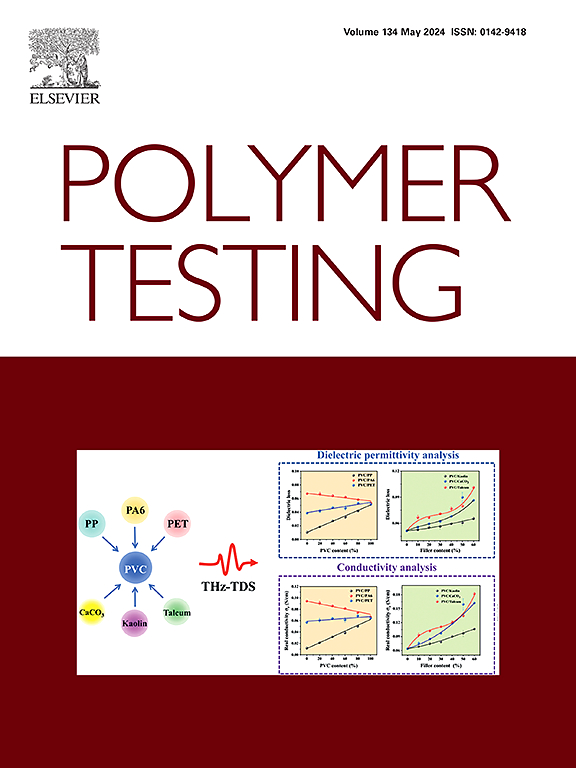具有可调构件的isatin基微孔聚合物膜:理解结构对气体传输性能和塑化行为的影响
IF 6
2区 材料科学
Q1 MATERIALS SCIENCE, CHARACTERIZATION & TESTING
引用次数: 0
摘要
在这项研究中,我们利用亲电的isatin和亲核的芳香族构建块通过超酸催化的frieel - crafts缩聚合成了微孔聚合物膜,以研究聚合物链填充结构对气体输运性能和塑化特性的影响。通过在不修改isatin的情况下调整芳香族构建块,我们控制了关键的结构参数,包括重复单元链长度、平面构象、旋转自由度和节段间相互作用。对合成聚合物的热力学性能、自由体积分数和链式填充结构进行了全面表征,以阐明结构变化对气体分离性能的影响。此外,通过结构表征阐明了由于不同构建模块而导致的气体分离性能的变化。值得注意的是,在合成的聚合物膜中,具有平面结构的聚合物膜由于其降低的对称性和相对极性的特性,在H2和CO2之间表现出最高的选择性。同时,受旋转自由度限制的微孔聚合物膜具有最高的尺寸稳定性和抗塑化能力,增强了气体分离过程中的稳定性。总的来说,本研究为isatin基微孔聚合物的结构-性能关系提供了基本的见解,为合理设计聚合物材料以实现高效稳定的气体分离提供了指导。本文章由计算机程序翻译,如有差异,请以英文原文为准。

Isatin-based microporous polymer membranes with tunable building blocks: Understanding structural effects on gas transport properties and plasticization behavior
In this study, we synthesized microporous polymer membranes using electrophilic isatin and nucleophilic aromatic building blocks via super-acid-catalyzed Friedel‒Crafts polycondensation to investigate the influence of polymer chain packing structures on gas transport properties and plasticization characteristics. By tuning the aromatic building blocks without modifying isatin, we controlled key structural parameters, including repeating unit chain length, planar conformation, rotational freedom, and inter-segmental interactions. The thermal and mechanical properties, fractional free volume, and chain packing structures of the synthesized polymers were thoroughly characterized to elucidate the impact of structural variations on gas separation performance. Further, variations in gas separation properties owing to different building blocks were elucidated through structural characterization. Notably, among the synthesized polymer membranes, the one with planar building blocks demonstrated the highest selectivity between H2 and CO2, attributed to its reduced symmetry and relatively polar characteristics. Meanwhile, the microporous polymer membrane with restricted rotational freedom exhibited the highest dimensional stability and plasticization resistance, enhancing stability during gas separation. Overall, this study provides fundamental insights into the structure–property relationships of isatin-based microporous polymers, offering guidance for the rational design of polymer materials for efficient and stable gas separation.
求助全文
通过发布文献求助,成功后即可免费获取论文全文。
去求助
来源期刊

Polymer Testing
工程技术-材料科学:表征与测试
CiteScore
10.70
自引率
5.90%
发文量
328
审稿时长
44 days
期刊介绍:
Polymer Testing focuses on the testing, analysis and characterization of polymer materials, including both synthetic and natural or biobased polymers. Novel testing methods and the testing of novel polymeric materials in bulk, solution and dispersion is covered. In addition, we welcome the submission of the testing of polymeric materials for a wide range of applications and industrial products as well as nanoscale characterization.
The scope includes but is not limited to the following main topics:
Novel testing methods and Chemical analysis
• mechanical, thermal, electrical, chemical, imaging, spectroscopy, scattering and rheology
Physical properties and behaviour of novel polymer systems
• nanoscale properties, morphology, transport properties
Degradation and recycling of polymeric materials when combined with novel testing or characterization methods
• degradation, biodegradation, ageing and fire retardancy
Modelling and Simulation work will be only considered when it is linked to new or previously published experimental results.
 求助内容:
求助内容: 应助结果提醒方式:
应助结果提醒方式:


